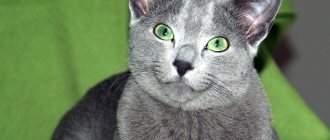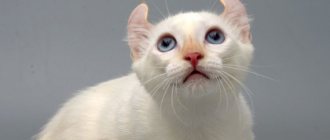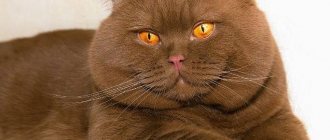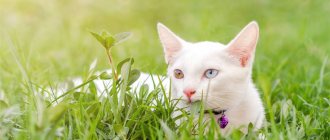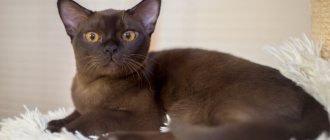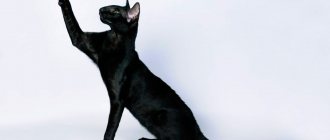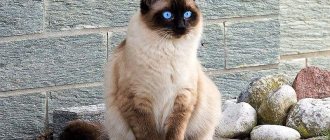The name of the breed, pixie-bob, is translated from English as "elf with a short tail", pixie-elf, bob- indicates a small tail. The appearance, reminiscent of a lynx, was inherited by this breed precisely from the wild cats of the American forests, which were actively used in selective work. The first pixie bob kitten appeared in the United States in 1985. This breed was bred by a group of non-professional felinologists, the leader of the group was Carol Brewer, who is the author of this breed. Work on developing the breed took many years; during experiments, domestic cats were crossed with wild ones caught in the forests until kittens with the appearance of a lynx appeared. After achieving the desired result, they tried to consolidate it. DescriptionCharacterCare
Origin story
The birthplace of the pixie bob is the USA. In the spring of 1985, in the Washington area, felinologist Carol Ann Brewer bought an unusual kitten: he had an unusual number of toes (polydactyly) and a short bob tail. A year later, the American woman saved another short-tailed cat. He was very large: almost as tall as a man’s knees and weighing 8 kg (and this despite his emaciated state). In size it can compete with Maine Coons.
From the mating of these two unique cats, a girl kitten was born, who became the ancestor of a new breed. She was named Pixie, which means "elf". It was covered with dark spots against a faun-colored background with a red tint. Pixie's muzzle was very similar to a lynx. A year later, Brewer began a program to breed a new breed of pixie bob.
Description of appearance
Even in the photo, the pixie-bob impresses with its powerful physique and impressive size.
- These are large cats with a strong and muscular build. They have a powerful, wide chest and a flat back with slightly protruding shoulder blades. There is a small fold of skin on the belly of cats.
- These animals can compete in weight and size with the Maine Coon cat breed, since the weight of adult individuals can reach from eight to ten kilograms. Interestingly, cats of this breed have especially pronounced sexual dimorphism, and females differ from males not only in their smaller size, but also in lighter weight, not exceeding five to six kilograms.
- The pixie bob cat has long and strong paws with wide, rounded pads. A distinctive feature of these animals is polydactyly, and many representatives of this breed have six or seven fingers. The hind legs are noticeably longer than the front legs.
- The tail of cats of this breed is short and straight, sometimes with slight kinks and bends.
- What distinguishes these animals from other short-tailed cats, in particular from the American Bobtail, is the unusual shape of the head. The head of mini-lynxes is not wedge-shaped, but pear-shaped. Another distinctive feature of these cats is the presence of whiskers, which makes these animals even more similar to a lynx.
- The nose is small and straight.
- Cats have small, widely spaced ears. There are fluffy tassels on the rounded tips of the ears.
- The eyes of mini-lynxes are large, oval-shaped and deep-set. Pixie bob kittens are always born with blue or light blue eyes, but as they mature their eyes become green, yellow or amber in color.
- Among these cats there are representatives with both long and short hair. Their fur is thick, soft and silky. The fur on the belly is fluffier than on the rest of the body.
- The color of mini-lynxes can be brown, red or gray. All over the cat's body there are spots and stripes that are darker in color than the main color. The fur on the belly, chest and inside of the paws is slightly lighter than on the back.
Detailed standard, color
According to the standards, there are several specific characteristics of the breed, the description of which is registered in official documents.
- The body is characterized by a strong build and well-developed muscles. The fore and hind limbs are long. There is a deflection of the spine between the shoulder blades and the pelvis. The pelvic girdle lies above the shoulder girdle. The body expands in the chest area, and a massive skin sac is defined on the abdomen. The paws are large in size and contain additional phalanges, however, the main toes must rest completely on the surface of the ground, and their direction must be strictly forward. The tail is short in length - maximum to the hock joint.
- The head has the shape of an inverted pear - a wide, fleshy chin, a narrower forehead. The eyes are deep-set, and there is a large amount of fur above them, arranged in tufts. The nose is quite wide, reddish in color.
- The coat can be either short or long. Pixiebobs are distinguished by their color - Brown Spotted Tabby, which is a variety of tabby characterized by a spotted pattern (wild color). Alternating elements should stand out clearly from the rest of the background. The fur on the surface of the belly is lighter. The letter M is defined on the muzzle in the forehead area. Around the eyes the fur is lighter. The mustache is of uneven color - the base is dark, the ends are white. The tip of the tail, as well as the paws, should be dark brown or black. The color generally varies from golden to gooseberry, that is, all shades of mouse color are allowed. A thin stripe runs from the corner of the eyes to the back of the cheeks.
Character
The wild appearance of the pixie bob does not reflect the character of the breed - loving, trusting, gentle. And although it largely depends on the specific animal, in general these cats are smart, easy-going, love people and are active.
In general, breeders say that pixiebobs are attached to the whole family, and can find a common language with each member. They usually don't choose just one. Some cats get along well even with strangers, although others may hide under the sofa at the sight of strangers.
Most people love to spend time with their family and follow their owners around. They get along well with children and love to play with them, provided they are gentle with them. However, they also get along well with other cats and friendly dogs. They understand words and phrases very well, and when you mention a veterinarian, you can search for your cat for a long time...
Quite quiet, pixiebobs communicate not by meowing (some do not meow at all), but by making a variety of sounds.
Care
The Pixiebob cat breed is easy to keep and does not require special care. To avoid heavy shedding, you can brush your pet with a special brush. However, the procedure is not mandatory. Cats shed twice a year – in autumn and spring. They bathe pixiebobs every month.
Particular attention is paid to individuals with polydactyls. These cats often have overgrown claws. To prevent such a problem, the owner must regularly trim the claws of his ward. The procedure must be performed once every 2 weeks.
Representatives of this breed are very energetic and active. Just like dogs, they need exercise. This pet needs attention.
- Cat meowing
- Alexandrian parrot
- Why does a cat need a mustache?
- Rescue dogs
- Hypoallergenic cats
- Why does a cat need a tail?
Pixiebobs are quite large cats; they feel comfortable only in a spacious room. Therefore, it is recommended to have them in a country house or in a large apartment.
Conclusions about the breed
Those who want to get a pet with a gentle and bright feline soul and a short tail need to understand who will join their family:
- the pixie-bob cat is demanding of attention and wants to reign supreme in the house, so other pets will be in a somewhat subordinate position;
- cats are smart, gentle, playful and sociable, which adults and children will appreciate;
- a purr with soft fur does not require any special care, but in terms of nutrition you will need to follow the diet and portion size;
- in rare cases, the manifestation of genetic diseases is possible;
- Amateurs are not recommended to breed the breed due to the difficulties associated with it.
I would like to say a big thank you to the diligence of felinologists who gave the world of domestic cats such an original and interesting creature.
Health, nutrition and physical care
Representatives of this breed are generally quite physically strong. Life expectancy is on average 13 years or more. As a rule, pixie bobs do not have hereditary diseases. However, over almost 40 years of existence of this breed, a number of cases of disturbances in the functioning of the genital organs have been noted.
And there were also cases of hypertrophic cardiomyopathy (HCM). Is it possible and how to establish the susceptibility of a particular individual to this disease? First, you need to find out whether the cat’s father or mother had this disease. If so, you should have your pet have an ultrasound every year to find out what its physical condition is.
This breed may be allergic to certain vaccines, so please consult your veterinarian before deciding to vaccinate.
The basis for the good health of an animal is proper weight, according to gender and age. For this reason, it is recommended to give food to these cats only a couple of times a day. It is better to feed pixiebobs with premium bagged food.
Cats of this breed have very dense fur, even those with short hair. So they need to be brushed at least once a week. This is necessary to remove dead hair and keep the fur healthy and shiny. Just as often, animals need to have their claws trimmed and their ears and mouth cleaned.
Education and training
A distinctive feature of this breed is intelligence. Nature has endowed animals with intelligence and good memory. Felinologists believe that pixiebobs understand the meaning of most words. If you talk about a visit to the veterinarian, the pet will prefer to retreat and sit somewhere under the bed.
At the same time, remember: representatives of the breed are not only smart, but also cunning. You will have to work hard before you find an approach to your pet and can start training. But some owners manage to train the pixie-bob to relieve itself in the toilet and even flush it after itself. This is a great way to save on litter, and just a reason to smile at your pet’s intelligence.
Animals understand the purpose of scratching posts and trays just as easily. The main thing is to start training your pixie bob as early as possible. Adult cats already have established habits and character. Changing them is more difficult, but still possible.
Pixiebobs especially appreciate active teams. By teaching your pet to fetch a toy or chase a thrown ball, you will please not only yourself, but also him. And combining training with a walk in a quiet park will make the animal the happiest in the world!
Offspring
Despite their good health, Pixiebob cats do not produce more than 3 kittens in one litter. However, you should not take your pet often. To ensure your cat's health remains strong, one birth per year will be enough. Caring for kittens is as simple as other breeds. At first, the mother cat takes care of them on her own. The owner can only change the diapers in the box and feed the cat well. When the kittens begin to eat on their own, they are given soft food. This can be special food for kittens or regular meat ground with porridge. You can also add vitamins for kittens. If you come across a Pixiebob kitten, you should take it without hesitation. These are beautiful, powerful, wild, and at the same time loyal and affectionate cats. They will be fun and not cause problems like many active domestic breeds.
What to look for when buying a kitten
When choosing a kitten, Pissybob breeders recommend going to a Pissybob nursery. The following indicators need to be taken into account when choosing:
- The appearance of kittens, which must be clean and well-groomed.
- The health of a piskibob should not be in doubt (a healthy kitten has clear eyes, shiny dense fur, a soft tummy).
- Pixiebob must be vaccinated according to his age.
- The color of the piskibob is usually decorated with noticeable dark spots. Although seven-toed dogs are not the main characteristic of the breed, you can pay attention to this characteristic feature.
- The shape of the kitten's head should resemble a pear.
Pixiebob breeders are confident that if the above signs are present in a pet, then it is a purebred representative of the Pixiebob breed.
Price of a pixie bob cat
The widespread distribution of this breed of cats is hampered by the poor tolerance of the descendants of wild lynxes to long journeys; therefore, exporting them outside the American continent can lead to unexpected problems. And buying pixiebobs is sometimes difficult for those who want to have such pets in their home. Such cats are not particularly fertile, and for the health of these creatures it is better not to mate them more than once a year.
Animals usually give birth to no more than three cubs in one litter. Pixie bob kittens, like all mammals, initially feed on their mother's milk. But when they grow up, it is better to feed them liquid porridge mixed with chopped meat. The price of pixiebobs can be very different, and can vary from 30,000 to 60,000 rubles, and depends on the place where the kittens are bought. They can be purchased in specialized nurseries, from breeders and abroad.
Video
Care and feeding of the pixie bob
Caring for a pet is not only about keeping it clean, healthy and fed. Pixie-bob owners need to remember that to maintain health and slimness, you need to play with your cat for 15-20 minutes every day, and in the summer you can easily teach your handsome dog to walk on a leash.
From childhood, pixie-bob kittens are taught all the mandatory hygiene procedures: they need to clean their ears with a cotton pad once a month and trim their claws.
Cats do not need hair trimming, but bathing should be done once a month or a month and a half with cat shampoo, this will be the necessary help for the animal in getting rid of excess hair.
What to feed a 2 month old kitten
Keeping representatives of the breed requires compliance with the diet and all feeding tips at different age periods. First of all, they are guided by the fact that both young and adult pixie-bobs cannot thoroughly digest carbohydrates. The pet's appetite is good, but you should not follow his lead: food is given according to the recommended portions.
You can feed pixie beans with dry food or natural products, or a combination of diets. To avoid getting into trouble and do everything correctly, you should take clear feeding instructions from the breeder.

